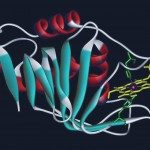Link to Pubmed [PMID] – 21510967
Toxicon 2011 Jul;58(1):8-17
Experimental evidence shows that the mechanism of pore formation by actinoporins is a multistep process, involving binding of the water-soluble monomer to the membrane and subsequent oligomerization on the membrane surface, leading to the formation of a functional pore. However, as for other eukaryotic pore-forming toxins, the molecular details of the mechanism of membrane insertion and oligomerization are not clear. In order to obtain further insight with regard to the structure-function relationship in sticholysins, we designed and produced three cysteine mutants of recombinant sticholysin I (rStI) in relevant functional regions for membrane interaction: StI E2C and StI F15C (in the N-terminal region) and StI R52C (in the membrane binding site). The conformational characterization derived from fluorescence and CD spectroscopic studies of StI E2C, StI F15C and StI R52C suggests that replacement of these residues by Cys in rStI did not noticeably change the conformation of the protein. The substitution by Cys of Arg⁵² in the phosphocholine-binding site, provoked noticeable changes in rStI permeabilizing activity; however, the substitutions in the N-terminal region (Glu², Phe¹⁵) did not modify the toxin’s permeabilizing ability. The presence of a dimerized population stabilized by a disulfide bond in the StI E2C mutant showed higher pore-forming activity than when the protein is in the monomeric state, suggesting that sticholysins pre-ensembled at the N-terminal region could facilitate pore formation.

